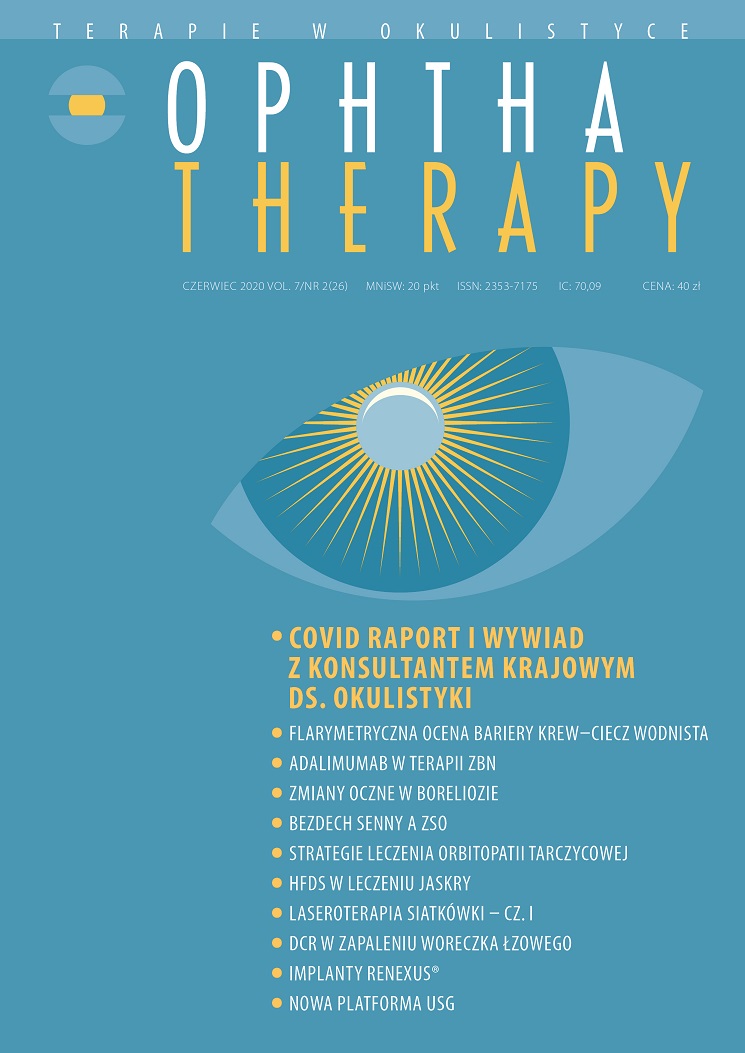Perspektywy zastosowania klinicznego nowego implantu RENEXUS® w teleangiektazjach okołoplamkowych typu 2 Artykuł przeglądowy
##plugins.themes.bootstrap3.article.main##
Abstrakt
Implant RENEXUS® firmy Neurotech Pharmaceuticals należy do nowoczesnych leków okulistycznych zarówno pod względem wykorzystanej w nim substancji czynnej, jak i formy jej podania do wnętrza gałki ocznej.
Substancją aktywną implantu jest rzęskowy czynnik neurotroficzny produkowany przez żywe ludzkie komórki nabłonka barwnikowego zawarte wewnątrz implantu. Rzęskowy czynnik neurotroficzny ma działanie ochronne na komórki siatkówki, dzięki czemu spowalnia ich utratę w przewlekłych schorzeniach degeneracyjnych oraz stanach zaburzonego ukrwienia.
Uważa się, że implant RENEXUS® może być wykorzystany w schorzeniach takich jak: teleangiektazje okołoplamkowe typu 2, zwyrodnienie barwnikowe siatkówki, neuropatia jaskrowa nerwu wzrokowego, przednia niedokrwienna neuropatia nerwu II, degeneracja plamki związana z wiekiem.
Czas aktywnego wydzielania substancji leczniczej do wnętrza gałki ocznej przez implant RENEXUS® ocenia się na ok. 5 lat.
Implant RENEXUS® przeszedł pomyślenie badania kliniczne II fazy i jest obecnie testowany w próbach klinicznych III fazy w leczeniu teleangiektazji okołoplamkowych typu 2.
Pobrania
##plugins.themes.bootstrap3.article.details##

Utwór dostępny jest na licencji Creative Commons Uznanie autorstwa – Użycie niekomercyjne – Bez utworów zależnych 4.0 Międzynarodowe.
Copyright: © Medical Education sp. z o.o. License allowing third parties to copy and redistribute the material in any medium or format and to remix, transform, and build upon the material, provided the original work is properly cited and states its license.
Address reprint requests to: Medical Education, Marcin Kuźma (marcin.kuzma@mededu.pl)
Bibliografia
2. Adler R, Landa KB, Manthorpe M et al. Cholinergic neurotrophic factors: intraocular distribution of soluble trophic activity for ciliary neurons. Science. 1979; 204: 1434-6.
3. Yu S, Tanabe T, Yoshimura N. A rat model of glaucoma induced by episcleral vein ligation. Exp Eye Res. 2006; 83(4): 758-70.
4. Valter K, Bisti S, Gargini C et al. Time course of neurotrophic factor upregulation and retinal protection against light-induced damage after optic nerve section. Invest Ophthalmol Vis Sci. 2005; 46(5): 1748-54.
5. Sieving PA, Caruso RC, Tao W et al. Ciliary neurotrophic factor (CNTF) for humar retinal degeneration:phase I trial of CNTF delivered by encapsulated cell intraocular implants. Proc Natl Acord Sci USA. 2006; 103: 3896-901.
6. Jaffe GJ, Tao W, Group CS. A Phase 2 study of encapsulated CNTF-secreting cell implant (NT-501) in patients with geographic atrophy associated with dry AMD-18 month results. Presented at the Association for Research in Vision and Ophthalmology Annual Meeting. May 2005, Fort Lauderdale, FL.
7. Zhang K, Hopkins JJ, Heier JS et al. Ciliary neurotrophic factor delivered by encapsulated cell intraocular implants for treatment of geographic atrophy in age-related macular degeneration. Proc Natl Acad Sci USA. 2011; 108: 6241-5.
8. Talcott KE, Ratnam K, Sundquist SM et al. Longitudinal study of cone photoreceptors during retinal degeneration and in response to ciliary neurotrophic factor treatment. Invest Ophthalmol Vis Sci. 2011; 52: 2219-26.
9. Gass JD, Oyakawa RT. Idiopathic juxtafoveolar retinal telangiectasis. Arch Ophthalmol. 1982; 100: 769-80.
10. Charbel Issa P, Gilles MC, Chew EY et al. Macular telangiectasia type 2. Prog Retin Eye Res. 2013; 34: 49-77.
11. Davidoff FH, Pressman HD, Chambers RB. Juxtafoveal telangiectasia name change? Retina. 2004; 24: 474-8.
12. Powner MB, Giliies MC, Zhu M et al. Loss of Muller cells and photoreceptors in macular telangiectasia type 2. Ophthalmology. 2013; 120: 2344-52.
13. Engelbrecht NE, Aaberg TM Jr, Sung J et al. Neovascular membranes associated with idiopathic juxtafoveolar telangiectasia. Arch Opthalmol. 2020; 102: 320-4.
14. Chew EY, Clemons TE, Jaffe GJ et al. Effect of Cliliary Neurotrophic Factor on Retinal Neurodegeneration in Patients With Macular Telangiectasia Type 2. Arandomized Clinal Trial. Ophthalmology. 2019; 126(4): 540-9.

